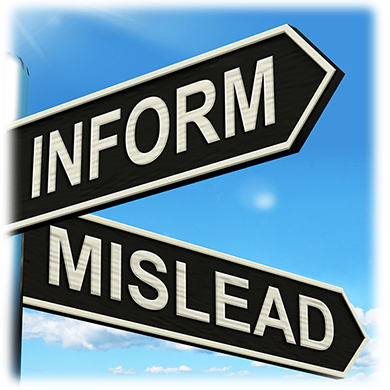Sub topic 2: Claims must not mislead
Claims must not mislead the reader either directly or by implication. Distorting the facts, exaggerating them or placing undue emphasis on certain facts can also be misleading. (This is also linked to the requirement for balance).
An example of misleading by omission would be presenting positive results of a secondary or exploratory endpoint on a clinical trial in which the primary endpoint was not met. If this important fact was not present in the material the reader could be misled into thinking the results were more significant than they actually were.

Misleading claims are often the subject of FDA warning letters.
Here are some examples
Misleading claims
The FDA issued a warning letter to Alvogen Inc. regarding a misleading sales aid. They stated
“Promotional materials are misleading if they fail to reveal facts that are material in light of the representations made by the materials or with respect to consequences that may result from the use of the drug as recommended or suggested by the materials.”
The product in question was Disulfiram. The sales aid contained the following with respect to the indication:
Indications and Usage: Disulfiram is an aid in the management of selected chronic alcoholic patients who want to remain in a state of enforced sobriety so that supportive and psychotherapeutic treatment may be applied to best advantage.
Product Category: Alcohol antagonist
The FDA cited two reasons for the sales aid being misleading. The first was the omission of any adverse event information. This was of particular concern as there was a black box warning for this product. The second was omission of a material fact from the product labelling which was:
“Disulfiram is not a cure for alcoholism. When used alone, without proper motivation and supportive therapy, it is unlikely that it will have any substantive effect on the drinking pattern of the chronic alcoholic.”
Both of these omissions would be likely to mislead the reader regarding the benefit to risk profile for the product

Misrepresentation of data
MSD were found in breach of the Australian Code of Conduct for a misleading representation of data for their
product Sevikar (olmesartan and amlodipine). The claim at issue was:
“Power to reach BP target in 7 out of 10 patients”
The data to support the claim were from the AZTEC study of Punzi et al 2010. A graph showed only those patients in the study that were up-titrated to the combination therapy (Sevikar) and omitted a histogram representing those patients who had achieved the blood pressure (BP) target on monotherapy (amlodipine) alone. There were 23.8 percent of patients who achieved the target BP on amlodipine alone and these were a subset of the total of 76.8 percent of patients who reached the BP target.
The Committee determined that the claim was misleading because it gave the impression that the outcome of 7 out of 10 patients achieving BP target was achieved only in patients using Sevikar combination therapy whereas this result was for patients on amlodipine monotherapy combined with those on the combination therapy.


